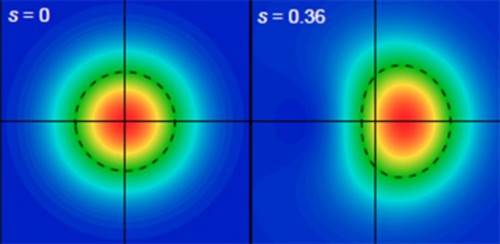Scientists at the University of Cambridge in the United Kingdom managed to measure a strange effect in quantum physics, according to which light particles are supposed to be "squeezed out" - an achievement that textbooks in the field wrote was hopeless

A team of scientists managed to measure how photons - the particles of light - are "squeezed out" in an experiment where it is written in the textbooks that it is impossible to measure the result in an experiment.
Blackmail is a strange phenomenon in quantum physics that uses a certain form of light that suffers from less "background noise" and can have a potential use in technologies designed to detect weak signals - such as gravitational waves.
The standard approach to light-squeezing is to shoot a powerful laser beam at a material, usually a non-linear crystal, and the collision between them produces the desired effect. For over 30 years theories have surfaced that there is another possible technique. This method involves exciting a single atom using a very small amount of light. The theory holds that the light scattered from hitting this atom should be distorted by a method known as squeezing of resonance fluorescence, Wikipedia - Production of light from an atom or molecule by means of particle bombardment, where the frequency of light emitted is the same as the frequency of light absorbed by the atom or molecule).
Although the theory was formulated back in 1981, the experiment designed to observe the phenomenon was so difficult to carry out that in at least one of the important physics textbooks the author sadly concludes "it seems hopeless to measure the phenomenon even if its existence has been proven so far".
In an article published in the journal Nature, the physicists reported that they succeeded in demonstrating the squeezing of individual light particles - photons. They used an experiment with an artificially produced atom - a quantum dot from a semiconductor material (Semiconductor Quantum Dot). Thanks to the improved optical properties of this system, and the technique they used to perform the tasks, they were able to observe the light as it was scattered and prove that it was squeezed.
Professor Mete Atature from St. John's College at the University of Cambridge in the United Kingdom who led the research said: "This is one of the cases where a basic question that the theory raised and which after years of experiments, people began to doubt the ability to observe it - is answered despite everything."
"We succeeded in this due to the fact that today we have in our possession artificial atoms with optical properties that exceed those of natural atoms. This means that we could reach the conditions necessary to observe this fundamental property of photons and prove that the strange phenomenon of squeezing does exist at the level of the single photon. This is a very strange phenomenon that goes against our senses and our expectations about the role of photons."
Explaining why the phenomenon occurs requires complex knowledge of quantum physics. Basically, this is a consequence of Heisenberg's Uncertainty Principle. According to this principle, in every situation a particle has two properties, but only one of them can be measured while the other is in uncertainty.
In the world of classical physics, these rules do not apply. If an object is in motion we can measure both its position and its momentum and thus know where it is moving and how long it will take to get there. A pair of these properties - position and momentum are related. In the strange world of quantum physics the situation is different. Heisenberg stated that only one part of the pair of properties can be measured and the other must remain uncertain.
In the Cambridge experiment, the researchers used this rule to their advantage when they created an alternative between what could be measured and what could not. By scattering the pale laser light from the quantum dot, the noise of the electromagnetic field was reduced to a precise low level, below the baseline of the quantum fluctuations. This silencing of the electromagnetic background noise was done at the expense of making other parts of the electromagnetic field less measurable, meaning that it would be impossible to create a noise level below zero without violating the Heisenberg Uncertainty Principle and hence also the laws of quantum physics.
The recording of the uncertainties of the fluctuations in the electromagnetic field on a graph creates a shape where the uncertainty on one side is reduced while on the other places it is expanded. This creates a compressed-looking shape, hence the term "squeeze light".
Atator added that the main point of the research was simply to try to measure this property of a single photon, because it had not been seen before. "This is exactly how we wanted to see what Pluto looks like up close." None of these things have immediate applications, but we know more than we did before. We do this because we are curious and we want to discover new things. This is the essence of science.”
to the notice of the researchers
More of the topic in Hayadan:

3 תגובות
Question for scientists:
Why is light both a wave and a particle? . I would love to know the answer.
Because if there is no answer to this, I have the answer and I would be happy to tell it to a physicist forum to know if there is any logic in my thinking.
I have been an electronics technician for 47 years.
likes to delve deeper into solving problems, and fixing strange faults.
Yes
Minor repairs:
In the explanation of the uncertainty principle, instead of momentum you once wrote angular momentum.
A little after that you wrote laws instead of researchers.